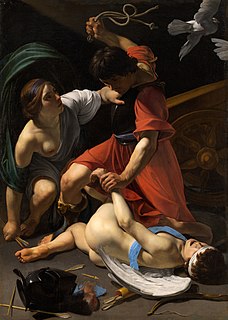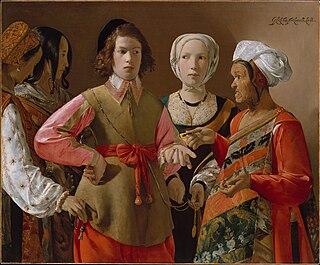A fortune teller is someone who practices fortune-telling.
Contents
Fortune teller may also refer to:
A fortune teller is someone who practices fortune-telling.
Fortune teller may also refer to:

Michelangelo Merisida Caravaggio, known as simply Caravaggio, was an Italian painter active in Rome for most of his artistic life. During the final four years of his life he moved between Naples, Malta, and Sicily until his death. His paintings have been characterized by art critics as combining a realistic observation of the human state, both physical and emotional, with a dramatic use of lighting, which had a formative influence on Baroque painting.
Super may refer to:
Resurrection refers to the coming back to life of the dead.

The Folies Bergère is a cabaret music hall, located in Paris, France. Located at 32 Rue Richer in the 9th Arrondissement, the Folies Bergère was built as an opera house by the architect Plumeret. It opened on 2 May 1869 as the Folies Trévise, with light entertainment including operettas, comic opera, popular songs, and gymnastics. It became the Folies Bergère on 13 September 1872, named after nearby Rue Bergère. The house was at the height of its fame and popularity from the 1890s' Belle Époque through the 1920s.
End of the world or The End of the World may refer to:
Attack may refer to:

The Caravaggisti were stylistic followers of the late 16th-century Italian Baroque painter Caravaggio. His influence on the new Baroque style that eventually emerged from Mannerism was profound. Caravaggio never established a workshop as most other painters did, and thus had no school to spread his techniques. Nor did he ever set out his underlying philosophical approach to art, the psychological realism which can only be deduced from his surviving work. But it can be seen directly or indirectly in the work of Rubens, Jusepe de Ribera, Bernini, and Rembrandt. Famous while he lived, Caravaggio himself was forgotten almost immediately after his death. Many of his paintings were reascribed to his followers, such as The Taking of Christ, which was attributed to the Dutch painter Gerrit van Honthorst until 1990.

Georges de La Tour was a French Baroque painter, who spent most of his working life in the Duchy of Lorraine, which was temporarily absorbed into France between 1641 and 1648. He painted mostly religious chiaroscuro scenes lit by candlelight.

Babes in Toyland is an operetta composed by Victor Herbert with a libretto by Glen MacDonough, which wove together various characters from Mother Goose nursery rhymes into a Christmas-themed musical extravaganza. Following the extraordinary success of their stage musical The Wizard of Oz, which was produced in New York beginning in January 1903, producer Fred R. Hamlin and director Julian Mitchell hoped to create more family musicals. MacDonough had helped Mitchell with revisions to the Oz libretto by L. Frank Baum. Mitchell and MacDonough persuaded Victor Herbert to join the production. Babes in Toyland features some of Herbert's most famous songs – among them "Toyland", "March of the Toys", "Go To Sleep, Slumber Deep", and "I Can't Do the Sum". The theme song "Toyland", and the most famous instrumental piece from the operetta, "March of the Toys", occasionally show up on Christmas compilations.
A miracle is an event that is inexplicable by natural or scientific laws and accordingly gets attributed to some supernatural or praeternatural cause.

The Fortune Teller is a painting by Italian Baroque artist Michelangelo Merisi da Caravaggio. It exists in two versions, both by Caravaggio, the first from c. 1594, the second from c. 1595. The dates in both cases are disputed.

The Cardsharps is a painting by the Italian Baroque artist Michelangelo Merisi da Caravaggio. The original is generally agreed to be the work acquired by the Kimbell Art Museum in 1987, although Caravaggio may have painted more than one version.

"Dark Lady" is a pop rock song recorded by American singer-actress Cher, and the title selection from her eleventh studio album, Dark Lady. Written and composed by John Robert "Johnny" Durrill and produced by Snuff Garrett, it was released as the album's first single in early 1974. The song became Cher's third solo U.S. #1 hit on March 22, 1974.

Valentin de Boulogne, sometimes referred to as Le Valentin, was a French painter in the tenebrist style.
A jukebox musical is a stage musical or musical film in which a majority of the songs are well-known popular music songs, rather than original music.

This is a list that shows references made to the life and work of Dutch artist Vincent van Gogh (1853–1890) in culture.
The Last Waltz is the 1976 final concert by The Band and a 1978 film documenting the concert.

Nicolas Régnier (1591–1667), known in Italy as Niccolò Renieri, was a painter, art dealer and art collector from the County of Hainaut, a French-speaking part of the Spanish Netherlands. He is often referred to as a Flemish artist because this term was often used to designate people from the Spanish Netherlands. After training in Antwerp, he was active in Italy where he was part of the international Caravaggesque movement. His subjects include genre scenes with card players, fortune tellers, soldiers and concerts, religious scenes, saints, mythological and allegorical scenes, and portraits. He also painted a few scenes with carnivals.

The Fortune Teller is an oil painting of circa 1630 by the French artist Georges de La Tour. The work was uncovered in about 1960 and purchased that year by the Metropolitan Museum of Art in New York. François Georges Pariset described the painting in The Metropolitan Museum of Art Bulletin, attributing it to La Tour—a likely choice given the calligraphic signature at top right: "G. de La Tour Fecit Luneuilla Lothar". Its authenticity has been questioned in the intervening years, notably by the English art historian Christopher Wright, but The Fortune Teller is generally accepted as La Tour's work. The artist is better known for his chiaroscuro religious compositions, in which the figures are illuminated by a single light source and lack the elaborate costume detail of The Fortune Teller's characters.

Marguerite Sylva was a Belgian born mezzo-soprano who achieved fame not only on the opera stage but also in operetta and musical theatre. She was particularly known for her performances in the title role of Bizet's Carmen, which she sang over 300 times in the course of her career. Sylva was a pioneering recording artist for Edison Records and made many recordings for the company between 1910 and 1912.